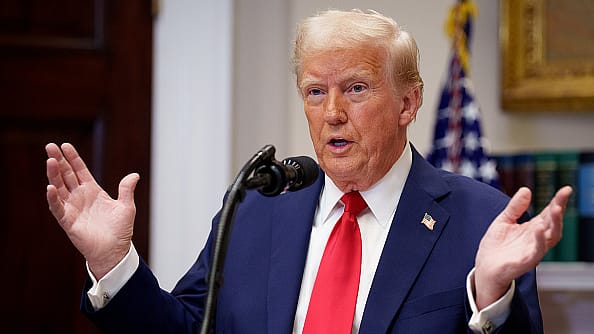How Trump’s 25% auto tariffs affect Indian companies
ADVERTISEMENT

U.S. President Donald Trump announced a sweeping 25% tariff on automobiles and auto parts imports into the United States from April 3, sending shockwaves through global automotive markets.
While the move is expected to hit Japanese, German and Korean automakers the most, Indian automobile manufacturers, except for Tata Motors’ luxury arm Jaguar Land Rover and Eicher Motor’s Royal Enfield motorcycles, don’t export vehicles to the U.S.
The U.S. accounts for nearly a third of JLR's global sales. All JLR cars sold in the U.S. are produced either in the UK or Europe. In the first eleven months of the financial year 2024-25, JLR sales increased 39% year-on-year in the US and its market share among the top-four premium OEMs (Audi, BMW, Mercedes, and JLR) increased to 10.9% from 8.4% in FY24, according to HSBC Research. Trump’s auto tariffs are particularly bad for JLR as the Tata group-owned carmaker is already witnessing an industry-wide slowdown in China.
India’s export-dependent auto parts makers like Samvardhana Motherson International, the country’s largest auto component exporter, and Sona BLW are going to be hit too. Vivek Chaand Sehgal-led Motherson, which operates over 400 units in 44 countries, has several auto component units in Mexico that mainly cater to the U.S. market. Mexico contributed 4% to the company’s revenues in FY24. Similarly, Gurugram-based Sona BLW, which gets over a third of its revenues from EV component exports, has manufacturing facilities in Mexico among other countries.
January 2026
Netflix, which has been in India for a decade, has successfully struck a balance between high-class premium content and pricing that attracts a range of customers. Find out how the U.S. streaming giant evolved in India, plus an exclusive interview with CEO Ted Sarandos. Also read about the Best Investments for 2026, and how rising growth and easing inflation will come in handy for finance minister Nirmala Sitharaman as she prepares Budget 2026.
India exported $2.2 billion worth of auto parts to the U.S. in 2024, comprising 29.1% of its global auto part exports, according to New Delhi-based think tank Global Trade Research Initiative (GTRI).
The U.S. imported $89 billion worth of auto parts globally last year, with Mexico accounting for $36 billion, China for $10.1 billion, and India for just $2.2 billion. Since the 25% tariffs apply across the board, all exporting countries face the same hurdle, said GTRI.
Yet, India’s auto sector remains largely insulated, according to GTRI. The trade policy think tank believes the implications for India’s auto industry remain limited—and may, in fact, present an opportunity for Indian exporters. “An analysis of India’s auto and auto component exports in calendar year 2024 suggests that the impact of these tariffs on Indian exporters will be minimal. In the case of passenger cars, for instance, India exported a modest $8.9 million worth of vehicles to the U.S., compared to $6.98 billion in global exports—meaning just 0.13% of India’s car exports are U.S.-bound. This negligible exposure implies the tariffs will have no real effect on India’s thriving car export business,” it said, adding that any lowering of tariffs by India to avoid tariffs on passenger cars would be counterproductive.
“In fact, the Australian experience offers a cautionary tale. When Australia reduced its import tariffs from 45% to 5% in the late 1980s, it paved the way for the eventual collapse of its domestic auto manufacturing industry. With the Indian auto sector contributing nearly one-third of the country’s manufacturing GDP, any similar misstep must be avoided. Preserving the stability of the Indian auto sector is vital,” said GTRI.
In other categories too, U.S. exposure is either low or manageable. Truck exports to the U.S. stood at just $12.5 million, representing 0.89% of India’s global truck exports, said GTRI.
“Some impact is likely in car chassis fitted with engines, where the U.S. accounted for $28.2 million of India’s $246.9 million in global exports (11.4%). However, this remains a small segment of India’s total auto exports,” it stated.
India’s auto component industry may even find an opening, thanks to its competitive advantage in labour-intensive manufacturing and competitive India’s import tariff structures (ranging from 0% to 7.5%), India could increase its market share in the U.S. over time, predicts GTRI. “Rather than retaliating, the Indian government should view the tariff move as a neutral—or even mildly advantageous—event in the long term,” it explained.
“With minimal direct exposure in most categories and potential upside in auto parts, there is little reason for India to counteract. Strategic patience may prove more rewarding than reciprocal,” said GTRI.
